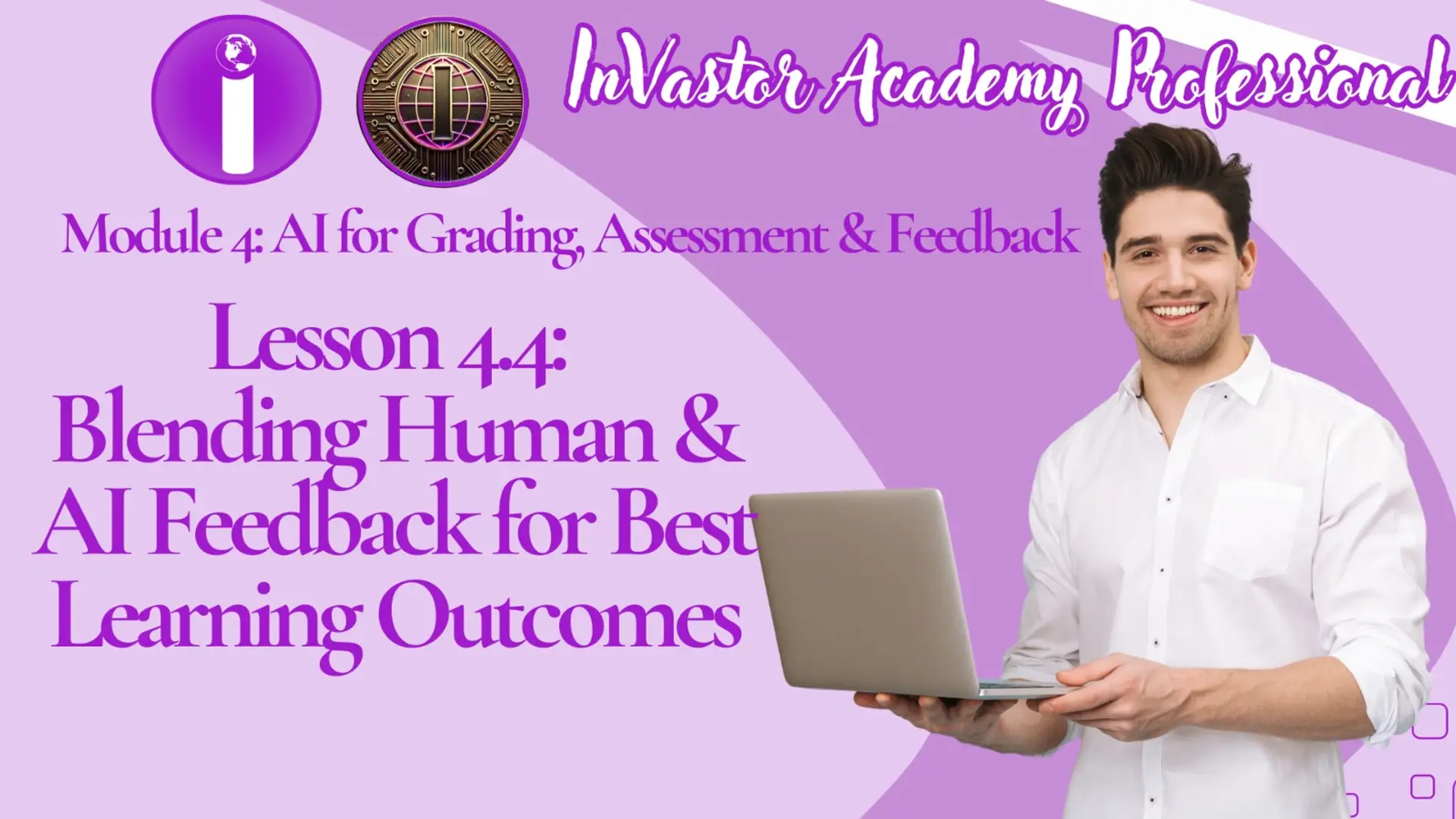

Module 4: AI for Grading, Assessment & Feedback Lesson 4.4: Blending Human & AI Feedback for Best Learning Outcomes
Module 4: AI for Grading, Assessment & Feedback
Lesson 4.4: Blending Human & AI Feedback for Best Learning Outcomes
Learning Objectives
By the end of this lesson, educators will be able to:
- Explain why combining AI feedback with human teacher feedback leads to better learning outcomes than either alone.
- Identify which types of feedback are best handled by AI and which require human judgment.
- Apply strategies for integrating AI-generated suggestions into student-centered feedback.
- Design a balanced feedback workflow that reduces educator workload while maintaining instructional quality.
- Encourage students to interpret, refine, and reflect on AI feedback responsibly.
1.Why Blending Human & AI Feedback Matters
AI can provide fast, data-driven, and scalable feedback, especially for large classes—but it lacks human emotional understanding, contextual awareness, and pedagogical intuition.
Teachers, on the other hand, excel in:

Therefore, the best educational outcomes happen when humans + AI collaborate, not when one replaces the other.
2.What AI Feedback Does Well
AI is most effective for:
✅ Grammar and language clarity suggestions
✅ Repetitive skill practice (math, language drills, structured writing)
✅ Identifying common errors and patterns
✅ Providing rubric-aligned scoring suggestions
✅ Drafting first-round formative feedback
Example AI Tools:
- ChatGPT / Gemini → content review + rewriting suggestions
- Turnitin / Copyleaks → originality and citation integrity
- Gradescope & Writable → rubric-based feedback automation
3. What Human Feedback Does Best
Teachers should handle:
✅ Emotional encouragement and motivation
✅ Interpretation of student intent and voice
✅ Feedback requiring subject mastery or deeper reasoning
✅ Support for students with learning differences
✅ Final grading decisions and performance assessment
Human feedback ensures that:
- Students feel supported, not just evaluated.
- Learning is personal and meaningful.
- Feedback aligns with classroom values and goals.
4. Strategies for Blending Feedback Effectively

Golden Rule:
AI may draft feedback, but teachers finalize and deliver it.
5.Teaching Students to Use AI Feedback Responsibly
Students should learn to:
- Review AI suggestions critically (not accept blindly)
- Verify facts and citations
- Preserve their own writing voice
- Reflect on what the feedback means for improvement
Reflection Prompts Teachers Can Use:
- “Which AI suggestions were helpful, and why?”
- “What changes did you decide not to use? Why?”
This builds metacognition and self-managed learning.
6.Classroom Example Workflow
Assignment: Personal Narrative Essay
Workflow:
- Student drafts → submits to AI for first-round clarity feedback
- Student revises based on selected suggestions
- Teacher reviews final draft focusing on meaning, creativity, and voice
- Teacher adds personal and motivational comments
- Student submits a self-reflection on revisions made
Result:
✔ Less teacher workload
✔ Higher student ownership
✔ Stronger learning outcomes
7.Supplementary Resources
- What Are AI Feedback Loops In Classroom Assessment? - Safe AI for The Classroom
- Reinforcement Learning from Human Feedback (RLHF) Explained
- Better workflow in the classroom
Lesson 4.4: Blending Human & AI Feedback for Best Learning Outcomes
You must score at least 70% to pass.
This quiz counts toward your certification progress.
Click here for Quiz 4.4:
Conclusion
Blending human and AI feedback allows educators to save time, maintain grading quality, and support deeper student growth. AI handles repetition, pattern detection, and initial suggestions, while teachers provide personal guidance, empathy, and academic interpretation. When used together intentionally, feedback becomes faster, more supportive, and more meaningful—leading to better student confidence and stronger learning outcomes.
Next and Previous Lesson
Next: Module 5: AI Tools for Detecting Plagiarism & Academic Integrity
Lessons:
5.1: What Plagiarism Looks Like in the AI Era
Previous: Lesson 4.3: Identifying Bias in Automated Grading Systems
AI for Educators: Personalized Learning & Content Creation
Related Posts
© 2025 Invastor. All Rights Reserved

User Comments